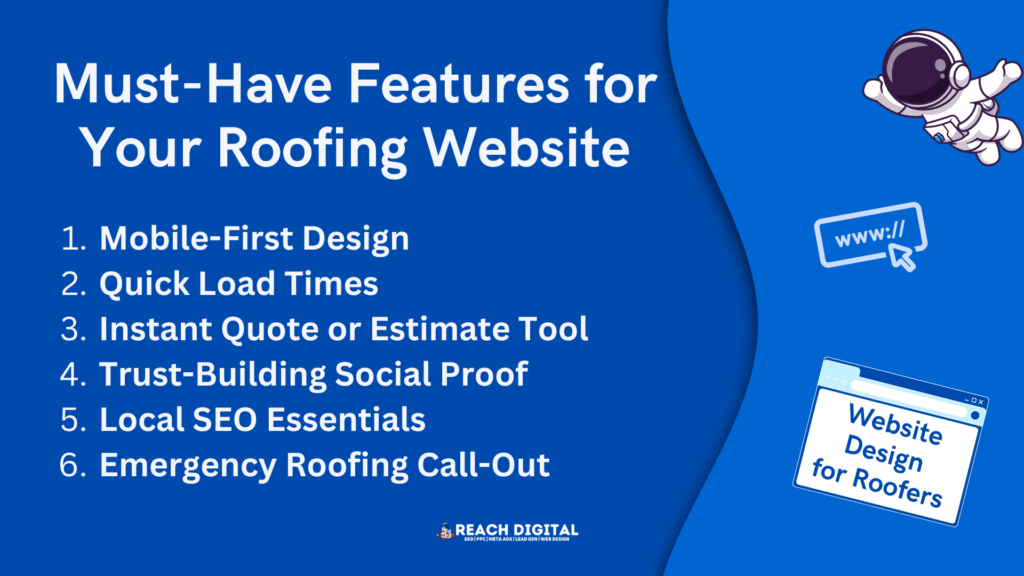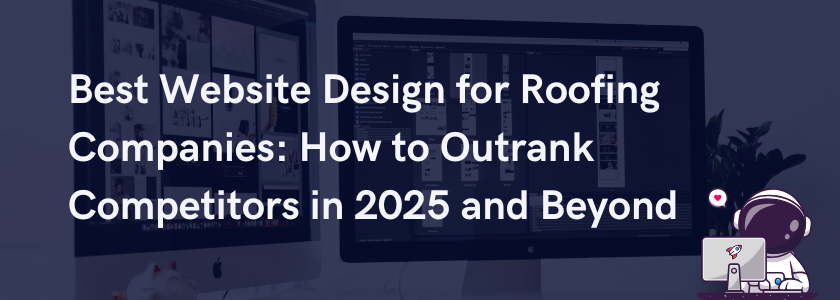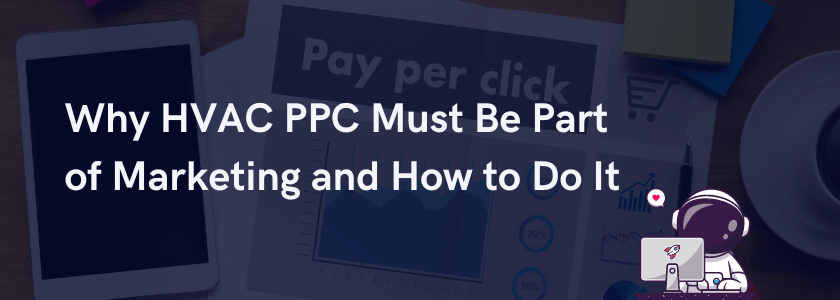A strong online presence starts with the best website design for roofing companies. Your website is your sales tool—it builds trust, captures leads, and helps you outperform competitors online.
But what makes a roofing website truly effective? In this guide, we’ll cover the must-have features, smart redesign strategies, and roofer SEO tips that set successful sites apart. Whether you need affordable web design services or a fully custom solution, you’ll find clear steps to create a roofing website that drives real results for your business.
Let’s get started.
What Makes a Great Roofing Website?
A high-performing roofing website turns visitors into customers. If you’re launching a new site or improving an existing one, these key elements separate the best from the rest:
Fast Loading Speed
Visitors expect your site to load quickly. If it takes longer than 3 seconds, you risk losing leads. Optimize images, enable browser caching, and choose a reliable hosting provider to maintain fast performance.
Mobile-Friendly Design
More than 60% of roofing searches happen on mobile devices. A responsive design ensures your site looks and functions properly on any screen. Google also favors mobile-friendly websites in search rankings, so this feature is essential.
Clear Call-to-Action (CTA) Buttons
Each page should lead visitors to take action. Place bold CTAs like “Get a Free Estimate” or “Call Now for Emergency Repairs” near the top of the page. Skip vague phrases like “Learn More” that don’t drive immediate engagement.
Simple Navigation
Confusing navigation can drive visitors away. A clear, well-organized menu helps people find what they need quickly and encourages them to stay on your site.
Start by structuring your menu around your main business areas. For a roofing company, that might include:
- Services: Add offerings like roof installation, repair, and maintenance
- Service Areas: List the cities or regions you serve
- About Us: Share your company’s story, values, and team
- Contact Us: Make it easy for visitors to get in touch or request an estimate
Use dropdown menus to keep your navigation clean. Nesting pages under broad categories helps visitors explore your site without feeling overwhelmed.
Trust-Building Elements
Trust is everything in the roofing industry. Your website should reflect that from the moment someone lands on it.
Add customer reviews and testimonials to highlight client satisfaction. Include a before-and-after gallery to show the quality of your work. Display certifications and industry affiliations to prove your expertise.
If you’re accredited by trusted organizations like the Better Business Bureau (BBB) or Angi, place their badges on your site. These signals help reassure potential customers that they’re dealing with a reputable roofing contractor.
SEO-Optimized Service Pages
Each roofing service you offer should have its own dedicated page. This not only improves SEO but also helps visitors quickly understand your full range of expertise.
Use specific keywords for each service, like “residential roof replacement” or “metal roof installation.” Include detailed descriptions of what the service involves, along with high-quality images or videos of your past work.
These pages are essential for helping your site rank in local searches and converting visitors into leads.
Your roofing website should be fast, easy to navigate, and built to build trust. Whether you’re handling it yourself or looking up “top roofing website designers near me,” these elements are the foundation of a site that brings in leads and turns them into customers.
Must-Have Features for Your Roofing Website in 2025

To convert more visitors, rank higher on search engines, and stay ahead of competitors, your roofing website needs to include these essential features:
Mobile-First Design
Google now uses mobile-first indexing, which means your site’s mobile version is what determines your search ranking. Make sure your mobile experience includes:
- Readable text without the need to zoom
- Buttons at least 48×48 pixels for easy thumb tapping
- Non-intrusive pop-ups that don’t block core content
A clean, mobile-friendly design improves both usability and visibility in search.
Quick Load Times
Speed plays a direct role in lead conversion and search rankings. Visitors won’t wait for a slow site—and Google won’t prioritize it either. To boost your site speed:
- Compress images using the WebP format to reduce size without losing quality.
- Use a Content Delivery Network (CDN) like Cloudflare or StackPath to serve content faster.
- Minimize redirects and avoid excessive plugins to reduce server requests.
- Streamline your website code and enable browser caching.
These upgrades help your site load in under 3 seconds—a benchmark that makes a real difference in user experience and conversions.
Instant Quote or Estimate Tool
Add interactive features to your site to reduce friction and boost conversions. A cost estimator based on square footage can give visitors a quick ballpark figure. Simplify lead capture with a one-click contact form that asks only for a name, phone number, and roof type. For added convenience, consider integrating a chatbot to answer FAQs and provide real-time support.
Trust-Building Social Proof
Establish credibility by showcasing real experiences and achievements. Add video testimonials from satisfied clients to highlight the quality of your work. Include badges from trusted organizations like NRCA or GAF Master Elite to show your commitment to professionalism. You can also feature case studies that walk visitors through past projects, timelines, and outcomes, reinforcing your expertise and reliability.
Local SEO Essentials
Strong local SEO helps attract nearby homeowners searching for roofing services. Be sure to:
- Integrate and optimize your Google Business Profile (GBP)
- Use schema markup to help search engines better understand and display your business information
- Create city-specific landing pages targeting relevant local keywords
For example, a dedicated page optimized for “Fort Lauderdale Roof Repair” can help you rank higher in searches from that area and draw in more qualified leads.
Emergency Roofing Call-Out
Capturing urgent leads requires fast, easy access to help. Add a 24/7 click-to-call button to your website so visitors can immediately connect with your team during a roofing emergency. A sticky header with your phone number ensures it’s always visible, no matter where they are on the site.
Create a dedicated emergency roofing services page that outlines your response times, service areas, and what customers can expect. This builds trust with homeowners who need immediate assistance.
Blogs with Roofing FAQs
A blog section dedicated to answering frequently asked questions about roofing is another way to engage your audience and establish your company as a helpful resource. Use it to answer common homeowner questions like:
- How to Spot Storm Damage
- 2025 Roofing Material Costs
- DIY vs. Pro Roof Repairs
Covering relevant, helpful topics not only builds trust but also boosts SEO by targeting keywords and addressing the needs of potential customers.
Secure Hosting & HTTPS
Website security is critical for protecting user data and maintaining search engine visibility. Be sure to:
- Install an SSL certificate to display the padlock icon and secure user information
- Run regular malware scans to detect and resolve threats quickly
- Set up automated backups (daily or weekly) to restore your site if needed
A secure website reassures visitors and helps your roofing business maintain a strong reputation online.
How to Redesign Your Roofing Website (Without Losing SEO Rankings)
Redesigning your roofing website can improve user experience and give your brand a fresh look, but without a strategic approach, it can also lead to a significant drop in SEO performance. Here’s how to protect your rankings during the redesign process:
Audit Your Current Website
Start by performing a full SEO audit using tools like Screaming Frog, SEMrush, or Ahrefs. This will help you understand how your site is currently performing and highlight areas for improvement.
- Document all high-ranking pages and note their traffic levels
- Record any backlinks pointing to your site
- Flag technical issues like 404 errors, slow-loading pages, or missing metadata
This data will guide your redesign and help you avoid losing valuable SEO momentum.
Preserve Your SEO Assets
Protect your existing SEO value by maintaining as much of your original URL structure as possible. If you must change URLs, set up 301 redirects to ensure users and search engines are sent to the right pages.
- Retain your optimized content, especially high-performing service pages
- Transfer all metadata, including title tags, meta descriptions, and header structures
- Keep internal linking consistent where applicable
These steps ensure your new site launches without sacrificing the SEO foundation you’ve built over time.
Improve While You Redesign
A redesign is the perfect time to strengthen your website’s SEO. Take advantage of the process to fix known issues and enhance your overall performance.
- Optimize page speed to load in under 2 seconds
- Add schema markup for your local business and services to improve search visibility
- Create dedicated service area pages to target location-specific keywords
- Strengthen internal linking between service pages to improve site structure and distribute link equity
Addressing these areas during the redesign can give your SEO a measurable boost once the new site goes live..
Content Migration Strategy
When moving content to your new website, it’s important to take a strategic approach to maintain your SEO rankings.
- Identify your top-performing pages based on traffic and conversions, and preserve their content
- Refresh outdated content instead of removing it, keeping it relevant and keyword-focused
- Improve readability while maintaining keyword targeting
- Enhance pages with visual elements like before-and-after galleries or videos to increase engagement
Thoughtful content migration helps preserve the value of your existing content while creating opportunities to improve it.
Technical SEO Checklist
Before taking your new site live, complete these technical steps to avoid search visibility issues:
- Submit an updated XML sitemap to Google Search Console
- Check for crawl errors and fix any that could block search engine access
- Verify that canonical tags are correctly implemented to prevent duplicate content problems
- Test and confirm all 301 redirects from old URLs to new ones to preserve traffic and rankings
Completing this checklist ensures your redesigned site is ready for both users and search engines from day one.
Post-Launch Monitoring
Once your redesigned roofing website is live, monitor its performance closely to ensure everything is functioning as intended.
- Track keyword rankings daily for the first two weeks to catch any major drops early
- Use Google Search Console to check for crawl errors, indexing issues, or warnings
- Keep an eye on organic traffic trends to spot unexpected dips that may signal deeper problems
Proactive monitoring allows you to catch and resolve issues quickly, protecting your SEO gains and ensuring a smooth transition.
A successful website redesign balances visual improvements with SEO preservation. Following the process we’ve outlined will help modernize your roofing company’s online presence without sacrificing hard-earned search rankings.
Best Roofing Websites in 2025
After analyzing hundreds of roofing websites, the following stand out for their conversion-focused design, technical excellence, and innovative features. Each demonstrates how to showcase roofing services while driving leads effectively:
All County Exteriors
All County Exteriors’ website effectively builds trust and engagement at first glance:
- Instant credibility with a prominent “40+ Years in Business” badge
- Clear value proposition in the headline (quality service for New Jersey residents)
- Streamlined navigation with well-organized service pages
- Interactive project map showcasing completed work across the state
The design promotes deeper engagement while delivering key information quickly, balancing quick conversions and prolonged interaction.
Why It Works:
- Builds trust fast with longevity proof
- Makes service areas obvious
- Turns project galleries into an interactive experience
Their above-the-fold strategy proves that what you show first matters as much as how you show it. This approach demonstrates how roofing websites can be informative and visually engaging without sacrificing load speed or usability.
Cloud Roofing
Cloud Roofing’s website grabs attention immediately with innovative visual elements and clear calls to action. The standout features of their site include:
- Full-screen video background showcasing expert handiwork
- Bold yellow/black color scheme that highlights CTAs
- Sticky contact bar (bottom of screen) with quote/phone buttons
- Trust badges displaying accreditations and client stats
Why It Works:
- Visual Impact: The video background creates instant engagement without slowing load times.
- Strategic Contrast: High-contrast design directs focus to conversion elements.
- Smart Navigation: The sticky bottom bar ensures contact options are always accessible.
Cloud Roofing proves that breaking conventions (like ditching a sticky header) can improve usability when paired with a strong visual hierarchy.
Retro Roofers
Retro Roofers stands out with its distinctive retro-inspired design that balances nostalgia with modern functionality. Some of the key features of their website are:
- Playful retro aesthetic using monochromatic blues and custom typography
- Strategic white space improves readability and focus
- Sticky minimalist header ensures navigation without disruption
- Rich video content showcasing their projects (not just static images)
Why It Works:
- Memorable branding—The consistent retro theme makes them instantly recognizable
- Modern usability—Despite the vintage look, the site performs like a contemporary website
- Visual storytelling—Heavy emphasis on video content builds trust through demonstration
The website of Retro Roofers shows that themed designs can be effective when combined with strong user experience (UX) principles. Additionally, the limited color palette they used demonstrates that a minimalist approach can enhance, rather than limit, a brand’s identity.
Houston Roofing and Construction
Houston Roofing & Construction’s website excels at combining local pride with conversion-focused elements. Some of its notable strengths include:
- Strategic color scheme (red, white, blue) reinforces Texas identity and trust
- Innovative dropdown menus combine text & visuals to preview service pages
- Social proof front and center: Immediate phone number/contact access and 250+ 5-Star online reviews
- Credibility builders: Elite qualifications, Pro Project Management Policy, and industry-leading warranties
Why It Works:
- Local Connection: Design choices instantly resonate with Houston/Texas audiences.
- Transparency: Hard claims (like in-house crews) are backed by evidence.
- Reduced Friction: Contact options appear in the header, footer, and dropdowns.
In the competitive roofing industry, differentiation matters, and Houston Roofing & Construction’s website stands out by proving its superiority through concrete differentiators rather than just listing services.
A Better Roofing Company
A Better Roofing Company’s website is a masterclass in conversion-focused design. It excels at guiding visitors with visual storytelling and the following key elements:
- Unmissable CTAs: Contrasting red “GET QUOTE” buttons (header/sticky) and phone number
- Dual-Path Engagement: “LEARN MORE” for researchers vs. instant “GET QUOTE” for ready buyers
- Strategic Visuals: Professional project photos (not generic stock images) showcase real work
Why It Works:
- Color Psychology: Light background makes red CTAs pop (11% higher click-through in tests)
- Frictionless Contact: Phone number is evident in the header
- Social Proof: Authentic project galleries build credibility better than stock imagery
A Better Roofing Company’s “dual CTA” approach (learn vs. buy) caters to potential customers at different stages of the sales funnel. This strategy demonstrates how every element in your website should serve a purpose, regardless of where your visitors are in their decision-making process.
Roofing Giant
Roofing Giant’s website is an excellent example of what a trust-building design should look like. It excels at converting visitors by utilizing the following key features:
- Video testimonials are prominently featured on both the homepage and a dedicated page
- Strategic above-the-fold elements, such as a 24/7 support claim with a lifetime warranty badge and immediate contact options (phone number + CTA button)
- Interactive photo gallery showing work progress without slowing load times
Why It Stands Out:
- Trust through multimedia combines video testimonials with written reviews and project visuals
- Urgency creation: Round-the-clock service messaging targets emergency repairs
- Educational content: The insurance restoration page, in particular, simplifies complex processes for homeowners
Roofing Giant’s website demonstrates the power of a well-designed online space in building trust and credibility. These elements generate a sense of reliability and professionalism, encouraging potential customers to choose their services.
Our top picks for the best roofing websites prove that strategic design directly impacts lead generation, whether through trust-building elements, intuitive navigation, or conversion-focused features. While these examples represent top-tier designs, exceptional results don’t always require premium budgets.
Affordable vs. Premium Web Design: What’s Right for You?
Choosing between budget-friendly templates and high-end custom roofing website design solutions depends on your business goals, market competition, and growth stage. Let’s break down both options to help you decide:
Affordable Roofing Web Design Services (Template-Based)
Best for: Startups or small roofing companies with limited budgets
✓ Pros:
- Lower upfront costs ($500–$5000)
- Faster launch (2–4 weeks)
- Built-in mobile optimization (via platforms like Wix or Squarespace)
✗ Cons:
- Generic layouts that are harder to stand out
- Limited SEO customization
- Scalability challenges as you grow
You may choose budget-friendly roofing web design services if your business operates in a limited local area, requires a simple online presence established rapidly, and can manage website updates yourself.
Pro Tip: Take the time to search for affordable roofing web design services to compare template providers
Premium Custom Roofing Website Design Solutions
Best for: Established roofing companies in competitive markets
✓ Pros:
- Unique design tailored to your brand
- Conversion-focused features (interactive calculators, CRM integration)
- Advanced SEO integration (local schema, speed optimization)
Investment
$5000-$15000+ (with ongoing maintenance)
Choose premium roofing website design solutions if your company is established and competes in multiple service regions or major metropolitan areas. This option also suits enterprises that require complex functionalities on their website, such as instant quoting, or those that want to rank for competitive keywords.
Pro Tip: Consider hiring “top roofing website designers near me” for localized expertise.
Hybrid Approach for Budget-Savvy Upgrades
If you don’t require a fully customized web design, you may opt to improve a template site with:
- Professional copywriting (targeting service keywords)
- Custom graphics (team photos, project galleries)
- Plugins for lead capture (chatbots, sticky CTAs)
This approach typically costs between $1000 and $3000 for strategic add-ons.
How to Decide
To determine if your roofing business needs a custom-designed website, consider the following questions:
- What’s your current customer volume? If you have a high volume of leads, a custom website will be a worthwhile investment to optimize conversions and support your business growth.
- How competitive is your area? If you operate in a major metropolitan market with numerous roofing companies, a premium website with advanced SEO features is essential to stand out and attract customers.
- Can you maintain it? If you lack dedicated IT staff, a template-based website might be a more practical choice, as these platforms typically offer user-friendly content management systems that require minimal technical expertise.
Pro Tip: Many roofing website designers offer free consultations—compare 3–5 proposals before committing.
Finding the Best Roofing Website Designers
Now that you’ve seen what makes a high-performing roofing website, the next step is choosing the right team to build or redesign yours. Whether you’re looking for affordable web design services or a fully customized site, use these tips to guide your decision:
Look for Roofing Industry Experience
Not all web designers have experience with contractor websites. It’s important to choose a team that understands the roofing industry and has a portfolio to back it up. They should be familiar with what drives conversions for roofers, including features like emergency call buttons, service area pages, and insurance claim sections. Industry-specific knowledge helps ensure your site is built to generate leads and speak directly to your ideal customers.
Evaluate Their Technical SEO Expertise
A good-looking site isn’t enough if it doesn’t rank in search results. Ask how the team handles mobile responsiveness, site speed, and core web vitals. It’s also important to understand their approach to preserving SEO during a redesign. They should be able to walk you through how they protect rankings, maintain backlinks, and avoid traffic loss. If they can show you roofing websites they’ve helped rank well in Google, that’s a strong sign of their capabilities.
Compare Pricing Models
When reviewing pricing options for roofing website designers, make sure you understand exactly what’s included in each package. Some designers charge a flat rate, while others bill hourly or base their fees on the project’s complexity. Always ask about additional costs such as hosting, domain registration, and ongoing website maintenance. These extras can add up quickly if they aren’t clearly outlined from the beginning.
Check Post-Launch Support
The right design team should support you beyond the launch. This includes training you on how to use your content management system so you can make simple updates on your own. They should also offer security monitoring and regular backups to protect your site from data loss or cyber threats. If possible, work with a designer who includes SEO maintenance to help your site stay visible in search results over time.
Red Flags to Avoid
As you evaluate potential designers, watch for warning signs. A lack of roofing-specific case studies may point to limited industry experience. Be cautious of anyone who guarantees top rankings on Google within a short time frame, as these promises often come from unreliable or unethical providers. Also, avoid working with anyone who doesn’t provide a clear contract or maintenance plan. Without those in place, you risk misunderstandings, hidden costs, and poor long-term support.
Future-Proofing Your Roofing Website
A high-performing roofing website should be flexible, fast, and equipped to grow alongside your business and technology. Here’s how to keep your site competitive as digital trends evolve.
Prioritize Core Web Vitals
Google’s algorithm increasingly favors websites that load quickly, remain visually stable, and offer smooth interactions. Aim for a load time under two seconds. Make sure your layout doesn’t shift as content loads, and ensure that buttons and forms respond immediately. These performance signals improve both user experience and search rankings.
Adopt AI-Powered Tools
AI tools can improve customer engagement and streamline your sales process. Chatbots are useful for answering questions and qualifying leads around the clock. You can also use dynamic content to personalize messaging based on a visitor’s location or behavior. Some roofing companies are even exploring AI-powered quote tools that generate estimates from uploaded roof photos, making the process faster and more convenient for customers.
Optimize for Voice Search
With more people using voice assistants to search online, your website should be optimized for natural language queries. Use question-based keywords like “How much does a metal roof cost?” and structure your content to provide clear, concise answers. Adding FAQ schema markup helps search engines recognize and display your answers in voice search results. Aim to keep responses under 40 words for the best chance of being featured.
Plan for Visual Search
Visual search is becoming a key part of how homeowners discover contractors, especially through platforms like Pinterest and Google Lens. To prepare your site for this trend, make sure every image includes descriptive alt text that clearly states the location and service. For example, using alt text like “Florida tile roof repair” helps search engines connect your images to relevant search queries.
You can also strengthen visual content by adding video walkthroughs of completed projects. These videos help build trust and give potential clients a closer look at your work. High-quality before-and-after galleries remain one of the most effective tools for showing the impact of your services and attracting new customers.
Build for Scalability
Your website should grow alongside your business. Choose a flexible platform like WordPress, which supports expansion and custom features better than limited builders like Wix. Structure your service pages so you can easily add new offerings as your business evolves.
Include a blog section with long-term potential. Over time, this can become a valuable content hub that attracts organic traffic and positions your company as a go-to roofing expert in your area.
Your 2025 Roofing Website Maintenance Checklist
✓ Quarterly speed/SEO audits
✓ Bi-annual content refreshes
✓ Annual design tune-ups (button styles, color contrasts)
Future-proofing isn’t about chasing every new trend. It’s about building a website that can evolve with changing technology and customer behavior. Start with the core strategies outlined above and grow your site thoughtfully. As your business scales, pair your website with roofing marketing ideas to drive leads, conversions, and long-term success.
Build a Website that Works for Your Roofing Business
The best website design for roofing companies goes beyond appearance. It should function as a lead-generating tool that builds trust, ranks in local searches, and turns visitors into customers. From mobile-first layouts to AI-powered features, your site needs to keep up with evolving technology to stay competitive in 2025 and beyond.
Whether you’re planning a full redesign or focusing on strategic updates, the right digital partner can help you create a roofing website that delivers real results.
🚀Ready to Outrank Your Competitors?
Our roofing digital marketing agency specializes in high-converting websites tailored to contractors. Claim your free website audit and let’s build a site that will skyrocket your business growth. Contact us today!





